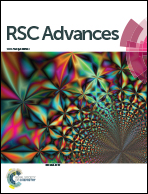Enhanced carrier transport in tris(8-hydroxyquinolinate) aluminum by titanyl phthalocyanine doping
Abstract
The effect of doping titanyl phthalocyanine (TiOPc) into tris(8-hydroxyquinolinate) aluminum (Alq3) (Alq3:T; where T represents TiOPc), used as an electron transport layer (ETL) for organic light emitting diodes (OLEDs), was investigated. The surface roughness of the doped thin films increases with the doping concentration as a result of a needle like 3D growth of TiOPc in Alq3. The electron mobility depends on the doping concentration. The electron mobility calculated in the trap-free space-charge limited region (SCLC) for a 2% doped Alq3 thin film was found to be 0.17 × 10−5 cm2 V−1 s−1 which is four orders of magnitude greater than that for pristine Alq3. The electroluminescence at a constant current density of 10 mA cm−2 is 3098, 4700, 7800, 3600 and 520 cd m−2 for Alq3 to Alq3:T(1%, 2%, 3% and 5%) devices, respectively. Similarly the power efficiency at a constant current density of 10 mA cm−2 is 2.1, 2.7, 4.2, 1.3 and 0.48 lm W−1 for the different doped devices Alq3 to Alq3:T(1%, 2%, 3% and 5%), respectively. The OLEDs based on the optimized 2% doped TiOPc in Alq3 show a four times increase in the electroluminescence as well as an almost doubling of the power efficiency. There are interfacial charges near the doped layer. The Cole–Cole plot indicates the device can be modeled as the combination of three parallel resistance–capacitance (R–C) equivalent circuits.


 Please wait while we load your content...
Please wait while we load your content...